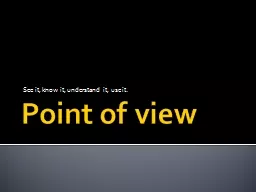

Whos talking Point of view is the angle from which the story is told To figure out point of view first ask yourself Who is the narrator The narrator of course is the voice telling the story ID: 806583
Download The PPT/PDF document "Point of view See it, know it, understan..." is the property of its rightful owner. Permission is granted to download and print the materials on this web site for personal, non-commercial use only, and to display it on your personal computer provided you do not modify the materials and that you retain all copyright notices contained in the materials. By downloading content from our website, you accept the terms of this agreement.
Slide1
Point of view
See it, know it, understand it, use it.
Slide2Who’s talking?
Point of view
is the angle from which the story is told.
To figure out point of view, first ask yourself, “Who is the narrator?”
The
narrator
, of course, is the voice telling the story.
Slide3First person
If the narrator is a character in the story, you’re reading first-person point of view.
“When I stepped out into the bright sunlight from the darkness of the movie house, I had two things on my mind: Paul Newman and a ride home.” – S.E. Hinton,
The Outsiders
Slide4Dead giveaway!
Pronouns give away point of view.
When we’re talking about ourselves, what pronoun do we use?
Slide5I, we, us!
So, why should a story character be any different?
If the narrator of a story uses “I,” the story is written in first person.
Caution:
Other
characters can use “I” if they’re
talking in the story.
Make sure you identify the narrator before you decide which point of view is being used.
Slide6Third person
Third-person point of view is when the narrator in a story is NOT a
character.
“Brian Robeson stared out the window of the small plane at the endless green northern wilderness below ... Not that he had much to say. He was thirteen and the only passenger on the plane was a pilot named – what was it? Jim or Jake or something – who was in his mid-forties and who had been silent as he worked to prepare for takeoff.” – Gary Paulsen,
Hatchet
Slide7Dead giveaway!
Which pronoun indicates that third person is being used?
Or, what pronouns do we use when we’re talking about someone else?
Slide8He, she, they, them, …
“
Brian Robeson
stared out the window of the small plane at the endless green northern wilderness below ... Not that
he
had much to say.
He
was thirteen and the only passenger on the plane was a pilot named – what was it? Jim or Jake or something – who was in his mid-forties and who had been silent as he worked to prepare for takeoff.” – Gary Paulsen,
Hatchet
Slide9What do you know?
Omniscience
: What is it?
Slide10What do you know?
Omniscience: Knowing everything
Omniscient: All-knowing
What does that have to do with point of view, you may
ask?
Slide11Omniscience
An author uses point of view to help tell the story. He or she chooses a point of view that will let him or her give the reader information at the right time.
Slide12Omniscient
Sometimes,
not very often, we
read stories written in third-person omniscient point of view.
What does that mean?
Slide13Omniscient
Third-person omniscient: The narrator is not a character and tells everything about everyone – thoughts, feelings, intentions, everything.
Why don’t we see omniscient point of view in first person?
Slide14Think about it!
Because the narrator would have to be a mind reader
! How else would he or she know everything about every character?
Slide15Limited omniscience
What do you think that means?
Slide16Limited omniscience
Limited omniscience is when the narrator knows only certain characters’ thoughts, feelings and intentions.
Third-person limited is a very common point of view. Why do you think that is?
Slide17Limited omniscience
If you were paying attention a few slides ago, you probably have the answer.
Using limited omniscience lets an author give the reader information – and hold back information – as he or she sees fit.
It helps preserve surprises and build suspense.
If we are told everything from the beginning, why would we read to the end of a story? Wouldn’t that be dull?
Slide18Why did we skip second person?
Well, the most obvious reason is that almost no one uses it in literature.
If first person uses “I,” third person uses “he” and “she,” what pronoun does second person use a lot?
Slide19You!
Authors use second person when they are addressing the reader directly.
When would you use second person when writing?
Slide20POV vs. perspective
Point of view and perspective are very similar. Do you know the difference?
Slide21POV vs. perspective
Like we discussed, point of view is the angle from which the story is told.
Even though Hatchet is told in third person, the story is told from one character’s perspective, or viewpoint. In third person, the character whose thoughts, feelings and intentions are known owns
the perspective.
Slide22Put point of view to work.
Read the selection from Hatchet. We know Hatchet is written in third-person limited point of view.
But what if we changed it?
Rewrite the selection and change the point of view as directed.